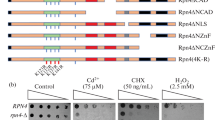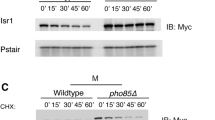Abstract
In undisturbed cells, the MAPK-activated protein kinase Rck2 of Saccharomyces cerevisiae is a stable protein with a turnover time exceeding 60 min. However, we have found that Rck2 is subject to intracellular degradation after exposure of cells to Zn2+ concentrations of 5 mM or more. In high-zinc medium, most of the Rck2 pool is degraded within 5 min. This degradation is blocked by inhibiting the vacuolar proteolytic pathway with the protease inhibitor phenyl methyl sulphonyl fluoride or by mutation of the PEP4 gene. By contrast, blocking the proteasomal pathway with the inhibitor MG132 does not prevent Rck2 degradation upon addition of Zn2+, nor is degradation inhibited in the proteasomal mutations pre1 pre2, cim3, or cim5. The stability of Rck2 is not affected by any of the other stress conditions examined, or by growth rate. Possible mechanisms of the degradation of Rck2 under high zinc conditions, and its physiological significance, are discussed.





Similar content being viewed by others
References
Asp E, Sunnerhagen P (2003) Mkp1 and Mkp2, two MAPKAP-kinase homologues in Schizosaccharomyces pombe, interact with the MAP kinase Sty1. Mol Genet Genomics 268:585–597
Bilsland E, Molin C, Swaminathan S, Ramne A, Sunnerhagen P (2004) Rck1 and Rck2 MAPKAP kinases and the HOG pathway are required for oxidative stress resistance. Mol Microbiol 53:1743–1756
Bilsland-Marchesan E, Ariño J, Saito H, Sunnerhagen P, Posas F (2000) Rck2 kinase is a substrate for the osmotic-stress activated MAP kinase Hog1. Mol Cell Biol 20:3887–3895
Brachmann CB, Davies A, Cost GJ, Caputo E, Li J, Hieter P, Boeke JD (1998) Designer deletion strains derived from Saccharomyces cerevisiae S288C: a useful set of strains and plasmids for PCR-mediated gene disruption and other applications. Yeast 14:115–132
Dahlkvist A, Sunnerhagen P (1994) Two novel deduced serine/threonine protein kinases from Saccharomyces cerevisiae. Gene 139:27–33
Ghislain M, Udvardy A, Mann C (1993) S. cerevisiae 26S protease mutants arrest cell division in G2/metaphase. Nature 366:358–362
Gitan RS, Luo H, Rodgers J, Broderius M, Eide D (1998) Zinc-induced inactivation of the yeast ZRT1 zinc transporter occurs through endocytosis and vacuolar degradation. J Biol Chem 273:28617–28624
Heinemeyer W, Gruhler A, Mohrle V, Mahe Y, Wolf DH (1993) PRE2, highly homologous to the human major histocompatibility complex-linked RING10 gene, codes for a yeast proteasome subunit necessary for chrymotryptic activity and degradation of ubiquitinated proteins. J Biol Chem 268:5115–5120
Ho Y et al (2002) Systematic identification of protein complexes in Saccharomyces cerevisiae by mass spectrometry. Nature 415:180–183
Jones EW (1991) Three proteolytic systems in the yeast Saccharomyces cerevisiae. J Biol Chem 266:7963–7966
Klionsky DJ, Cueva R, Yaver DS (1992) Aminopeptidase I of Saccharomyces cerevisiae is localized to the vacuole independent of the secretory pathway. J Cell Biol 119:287–299
Loewith R, Jacinto E, Wullschleger S, Lorberg A, Crespo JL, Bonenfant D, Oppliger W, Jenoe P, Hall MN (2002) Two TOR complexes, only one of which is rapamycin sensitive, have distinct roles in cell growth control. Mol Cell 10:457–468
Lyons TJ, Villa NY, Regalla LM, Kupchak BR, Vagstad A, Eide DJ (2004) Metalloregulation of yeast membrane steroid receptor homologs. Proc Natl Acad Sci USA 101:5506–5511
MacDiarmid CW, Gaither LA, Eide D (2000) Zinc transporters that regulate vacuolar zinc storage in Saccharomyces cerevisiae. EMBO J 19:2845–2855
MacDiarmid CW, Milanick MA, Eide DJ (2003) Induction of the ZRC1 metal tolerance gene in zinc-limited yeast confers resistance to zinc shock. J Biol Chem 278:15065–15072
Mahtani KR, Brook M, Dean JL, Sully G, Saklatvala J, Clark AR (2001) Mitogen-activated protein kinase p38 controls the expression and posttranslational modification of tristetraprolin, a regulator of tumor necrosis factor alpha mRNA stability. Mol Cell Biol 21:6461–6469
Martelli A, Moulis JM (2004) Zinc and cadmium specifically interfere with RNA-binding activity of human iron regulatory protein 1. J Inorg Biochem 98:1413–1420
Polymenis M, Schmidt EV (1997) Coupling of cell division to cell growth by translational control of the G1 cyclin CLN3 in yeast. Genes Dev 11:2522–2531
Radisky DC, Snyder WB, Emr SD, Kaplan J (1997) Characterization of VPS41, a gene required for vacuolar trafficking and high-affinity iron transport in yeast. Proc Natl Acad Sci USA 94:5662–5666
Ramne A, Bilsland-Marchesan E, Erickson S, Sunnerhagen P (2000) The protein kinases Rck1 and Rck2 inhibit meiosis in budding yeast. Mol Gen Genet 263:253–261
Sanchez-Piris M, Posas F, Alemany V, Winge I, Hidalgo E, Bachs O, Aligue R (2002) The serine/threonine kinase Cmk2 is required for oxidative stress response in fission yeast. J Biol Chem 277:17722–17727
Smith JA, Poteet-Smith CE, Lannigan DA, Freed TA, Zoltoski AJ, Sturgill TW (2000) Creation of a stress-activated p90 ribosomal S6 kinase. The carboxyl-terminal tail of the MAPK-activated protein kinases dictates the signal transduction pathway in which they function. J Biol Chem 275:31588–31593
Smith DA, Toone WM, Chen D, Bähler J, Jones N, Morgan BA, Quinn J (2002) The Srk1 protein kinase is a target for the Sty1 stress-activated MAPK in fission yeast. J Biol Chem 277:33411–33421
Teige M, Scheikl E, Reiser V, Ruis H, Ammerer G (2001) Rck2, a member of the calmodulin-protein kinase family, links protein synthesis to high osmolarity MAP kinase signaling in budding yeast. Proc Natl Acad Sci USA 98:5625–5630
Zhao H, Eide D (1996a) The yeast ZRT1 gene encodes the zinc transporter protein of a high-affinity uptake system induced by zinc limitation. Proc Natl Acad Sci USA 93:2454–2458
Zhao H, Eide D (1996b) The ZRT2 gene encodes the low affinity zinc transporter in Saccharomyces cerevisiae. J Biol Chem 271:23203–23210
Acknowledgements
We thank Valérie Goguel and Matthias Peter for yeast strains and helpful advice. This work was supported by the Swedish Cancer Fund (2163-B03-14XAB) and the Swedish Research Council for Science and Technology (2003-3189). S.S. was the recipient of a fellowship from the Foundation for Strategic Research.
Author information
Authors and Affiliations
Corresponding author
Additional information
Communicated by M. Collart
Rights and permissions
About this article
Cite this article
Swaminathan, S., Sunnerhagen, P. Degradation of Saccharomyces cervisiae Rck2 upon exposure of cells to high levels of zinc is dependent on Pep4. Mol Genet Genomics 273, 433–439 (2005). https://doi.org/10.1007/s00438-005-1151-8
Received:
Accepted:
Published:
Issue Date:
DOI: https://doi.org/10.1007/s00438-005-1151-8




